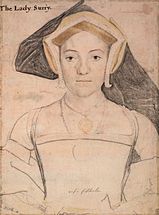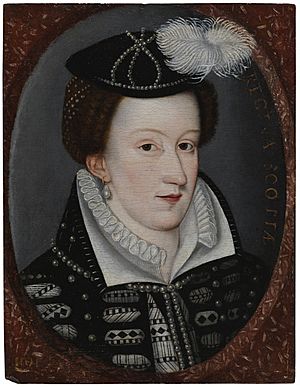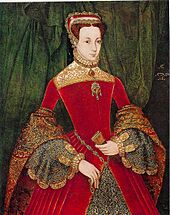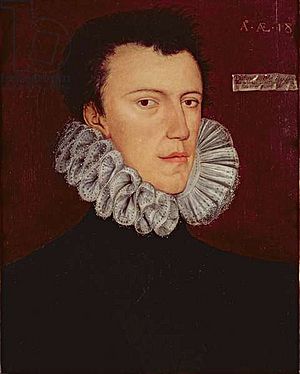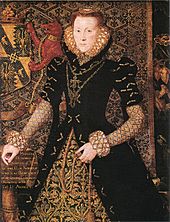Thomas Howard, 4th Duke of Norfolk facts for kids
Quick facts for kids
Thomas Howard, 4th Duke of Norfolk
|
|
|---|---|
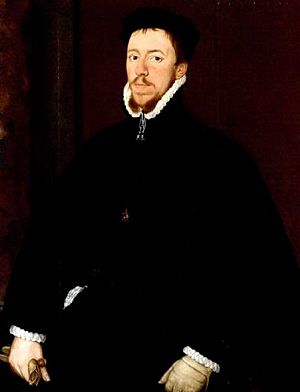
Thomas Howard painted by an unknown artist, c. 1565.
|
|
| Personal details | |
| Born | 10 March 1536 Kenninghall, Norfolk |
| Died | 2 June 1572 (aged 36) Tower Hill, London, England |
| Resting place | Chapel of St Peter ad Vincula, Tower of London |
| Spouses | Mary FitzAlan Margaret Audley Elizabeth Leyburne |
| Children | Philip Howard, 13th Earl of Arundel Thomas Howard, 1st Earl of Suffolk Lord William Howard Lady Elizabeth Howard Lady Margaret Howard |
| Parents | Henry Howard, Earl of Surrey Frances de Vere |
| Religion | Roman Catholicism |
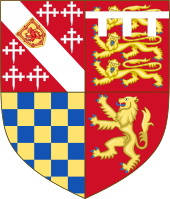
Thomas Howard, 4th Duke of Norfolk, KG (10 March 1536 – 2 June 1572) was an English nobleman and politician. He was a second cousin of Queen Elizabeth I and held many high offices during the earlier part of her reign.
Norfolk was the son of the poet, soldier and politician Henry Howard, Earl of Surrey. He is believed to have commissioned Thomas Tallis, probably in 1567, to compose his renowned motet in forty voice-parts, Spem in alium.
He was executed for his role in the Ridolfi plot.
Contents
Early life, family, and religion

Thomas was born at Kenninghall, Norfolk on 10 March 1536, the eldest son of Henry Howard, Earl of Surrey and his wife Lady Frances de Vere. His paternal grandparents were Thomas Howard, 3rd Duke of Norfolk, and Elizabeth Stafford. His maternal grandparents were John de Vere, 15th Earl of Oxford, and Elizabeth Trussell. His siblings were Jane, born in 1533 or 1537, Henry, born in 1540, Katherine, born in 1543 and Margaret, born in 1547, shortly after her father's execution. Thomas was therefore the eldest son. Between his maternal and paternal families, the religious differences were notable: his maternal grandfather was a supporter of the Reformation and was the first Protestant earl of Oxford, whereas his paternal grandfather was the premier Catholic nobleman of England although he had complied with the changes in the governance of the Church of England brought about by Henry VIII, and served the King in suppressing rebellion against those changes.
Thomas' father, the Earl of Surrey, a Catholic but with reformist leanings, was heir to the 3rd Duke, and thereby destined to become the future 4th Duke; but that changed at the end of 1546 when Surrey quartered the royal arms of Edward the Confessor on his own coat of arms, incurring the fury of Henry VIII. Through his great-grandfather John Howard, 1st Duke of Norfolk (1483 creation), Surrey was a descendant of Thomas of Brotherton, 1st Earl of Norfolk, the sixth son of King Edward I; and the arms of the Howard ancestor Thomas de Mowbray, 1st Duke of Norfolk (1397 creation) show that Surrey was entitled to bear Edward the Confessor's arms; but to do so was an act of pride, and provocative in the eyes of the Crown. Henry was also possibly influenced by the Seymours, who were enemies of the Howard family, supporters of Protestantism and related to Henry's son Prince Edward, since the Prince was the son of Henry's third wife Jane Seymour. Henry, who was increasingly unwell, became convinced that Surrey and his father planned to usurp the crown from Edward in order to reverse the Reformation and return the English Church to papal jurisdiction. He ordered the arrest of the Duke and his son, both of them being tried for high treason and later sentenced to death; Surrey was executed on 19 January 1547. The Duke's execution was scheduled for 28 January but did not take place because Henry VIII died in the early hours of the same day, the Privy Council made a decision not to inaugurate the new reign with bloodshed, but Howard remained a prisoner in the Tower of London for the next six years, with most of his property and titles forfeit to the Crown.
After Surrey's death, his sister Mary Howard, Dowager Duchess of Richmond took over the care of his children and John Foxe, the Protestant martyrologist was employed to be their tutor, at the suggestion of Lord Wentworth. During that time, they lived in Reigate Castle, one of the residences belonging to the 3rd Duke. From Foxe, the children learned Greek and Latin to a level where they "could compete with the most learned men of the age". Charles Howard, a first cousin from Surrey born the same year as Thomas, also studied and brought up with the children at Reigate. Despite losing his position as tutor six years later, Foxe remained an important recipient of Thomas' patronage for the rest of Howard's life. Although both Thomas and his siblings received a Protestant education, they were Catholics, as were most of their paternal family, who remained loyal to the Roman Church during the turbulence of the Reformation. His father fell out of favour in part because he had been a Catholic, and his grandfather remained a prisoner in the Tower throughout the reign of Edward VI, being released and pardoned in August 1553, shortly after the Catholic Queen Mary I ascended the throne. As soon as the 3rd Duke was released, he took charge of his grandchildren and dismissed Foxe, who soon went into exile in various countries in Continental Europe to escape the anti-Protestant measures taken by Queen Mary. Thomas then studied for a while at the home of the Bishop of Winchester and later Lord Chancellor Stephen Gardiner. A short time later, he joined his younger brother Henry, and continued his education in the London house of John White, a priest devoted to Catholic principles who in March 1554 was chosen to be the new Bishop of Lincoln.
Career
Because his father had died before his grandfather, Thomas was now in line to become 4th Duke of Norfolk. In 1553 he received the courtesy title of Earl of Surrey, a subsidiary title of the dukes, when Queen Mary returned to the 3rd Duke the titles and properties that had been forfeited six years earlier. In early 1554 the young Howard joined his grandfather in leading the forces that suppressed Wyatt's Rebellion, led by a group of Protestants who opposed Queen's projected marriage to Philip II of Spain. This was the last service to the Crown for the elderly 3rd Duke. In July of the same year, Thomas became first gentleman of the chamber to Philip.
After his grandfather's death in August 1554, Thomas succeeded him as 4th Duke and hereditary Earl Marshal of England. Howard had been gradually preparing to take over the administration of the vast family estates; he arranged his grandfather's funeral and burial at Framlingham and made suitable arrangements for the wardship of his sisters. Bassingbourne Gawdy, one of the lawyers in charge of the succession to Howard's estates, rode post haste to London with letters for Lord Chancellor Gardiner and returned as speedily as he could to Norwich. The escheator of Norfolk held a formal inquisition to survey the great Howard inheritance, of fifty-six manors, and 'many other considerable estates', which passed for the present into the hands of the Crown, as Thomas was still a minor. In due course, the young Duke would inherit the property. His younger siblings would also receive 1,000 marks each on coming of age, or marriage, according to the terms of their grandfather's will. Once he came of age in March 1557, the Duke was able to administer of all his estates, becoming one of the richest landowners in England.
In September 1554, Thomas arranged for the marriage of his sister Katherine to Henry Berkeley, 7th Baron Berkeley; this took place at Howard's mansion at Kenninghall.
Queen Mary died in November 1558 and was succeeded by her Protestant half-sister Elizabeth I. Howard was a second cousin of Elizabeth through her maternal grandmother, Lady Elizabeth Howard, sister of the 3rd Duke and mother of Anne Boleyn, and he was trusted with public office despite his family's history and leanings towards the Catholic Church.
As Earl Marshal, Howard was in charge of organising Elizabeth's coronation on 15 January 1559 and the celebrations afterwards. Shortly after ascending the throne, the Queen made Norfolk a Knight of the Garter. Although favoured by Elizabeth, Norfolk was jealous of the greater measure of confidence she placed in Robert Dudley. Furthermore, Howard considered William Cecil, Elizabeth's Secretary of State, to be "Low Born". In November 1559, Howard was appointed Lieutenant-General of the North, a post that he accepted reluctantly because he saw it, probably correctly, as a means of distancing him from court. He was given command of the army that would intervene in Scotland to support the Lords of the Congregation, a group of Protestant nobles opposed to the pro-French government of the regent, Mary of Guise, mother of Mary, Queen of Scots who was then living in France. By his side were placed a man of military experience, James Croft, and the diplomat and politician Sir Ralph Sadler, both with vast knowledge of Scottish political affairs. Howard immediately left for the north, arriving at Berwick in early January 1560. His duty was to provide forces for the defence of the town against a possible French attack, to open up communications with the leader of the Congregation, the Earl of Arran and cautiously aid them in their measures against the regent. Norfolk was one of the negotiators of the Treaty of Berwick, signed in February 1560, through which the Congregation invited English assistance, and was able to return to court after Cecil and his collaborators arrived in Edinburgh in July of the same year to sign the Treaty of Edinburgh which ended English assistance.
Mary Queen of Scots and the Rising of the North
Norfolk was the principal commissioner at the conference held in York in October 1568 to hear evidence against Mary, Queen of Scots, who had been a prisoner in England since she fled Scotland in May of that same year after being defeated at the Battle of Langside and abdicating under duress. The evidence was presented by Mary's illegitimate half-brother James Stewart, 1st Earl of Moray, who was also Scottish regent because Mary's son King James VI was still a young child. The evidence included the casket letters, which came to light during the investigations carried out in relation to Mary's alleged involvement in the murder a year earlier of her second husband Henry Stewart, Lord Darnley.
Having lost his third wife, and despite having presided at the York commission, Norfolk began to plan marriage to Mary. For both parties, it would have been their fourth marriage; Howard had been widowed three times, whilst Mary had been widowed twice and her third husband, James Hepburn, 4th Earl of Bothwell, had escaped but ended up as a prisoner in Denmark. Both Howard and Mary were descended from the House of Plantagenet. Furthermore, the former Scottish monarch had a strong claim to the English crown as a descendant of Henry VII, the first monarch of the reigning Tudor dynasty, through her paternal grandmother Margaret Tudor, and was considered by many Catholics to be the rightful queen of England due to Elizabeth's Protestantism. Supporters of Mary's claim to the throne thereby hoped to bring about the restoration of Catholicism. This represented a serious threat to Elizabeth. Both the Scottish statesman William Maitland of Lethington and the Bishop of Ross, John Lesley, Mary's chief adviser and agent, were in favour of the Duke's marriage to the former Scottish queen, and Mary herself consented to it, although Howard was initially reluctant to bring about political and religious change. During recesses from the conference in York, Maitland met privately with Norfolk, suggesting to the Duke the possibility of marrying Mary, as well as a possible future marriage between Howard's daughter, Margaret and the infant King James VI. Norfolk saw in this proposal not only the means to solve the succession crisis which had plagued England ever since Elizabeth's accession, given her reluctance to marry and produce an heir, but also an opportunity for his own social aggrandisement. Furthermore, Mary's marriage to the leading English nobleman would help the former Scottish monarch to strengthen her claim to the throne.
Initially the relationship between Norfolk and the former Scottish sovereign was platonic and they communicated through letters. Mary sent Norfolk a gift of a pillow embroidered with the Stewart family motto Virescit vulnere virtus (courage grows strong at a wound) and her coat of arms. The Duke, through Lord Boyd, a member of Mary's private circle, sent a diamond to be delivered to her as a token of his affection and fidelity. Mary, grateful for the gift, wrote to Norfolk in December 1569 that she "I took the diamant from my lord Boyd, which I shall kepe unseene about my neck till I give it agayn to the owner of it and me both.".
A marriage to Mary would have given the Duke a political advantage at court, as he was by now a rival of Elizabeth's favourite, Dudley, and an enemy of Cecil. The marriage scheme with Mary was supported by most of the Catholic nobility, and some assumed that the Duke was willing to lead a revolt against Elizabeth. In November 1569 the Rising of the North broke out, organised by Charles Neville, 6th Earl of Westmorland, Norfolk's brother-in-law, and Thomas Percy, 7th Earl of Northumberland. Howard briefly participated in the revolt, hoping that if he succeeded, he would achieve the release of Mary, who was then being held in Tutbury Castle. It is still debated whether the rebellion actually aimed to overthrow Elizabeth, and whether Mary even knew about it beforehand. After initial successes, Westmorland and Northumberland were forced to escape to Scotland when Elizabeth sent forces north under Thomas Radclyffe, 3rd Earl of Sussex to quell the rebellion. Norfolk tried to stop the revolt when he saw that it was going to fail, but Elizabeth ordered his arrest after receiving news that the rising had taken place.
Norfolk was a prisoner in the Tower of London until August 1570 when he was released for lack of evidence, and also because he confessed his intentions and begged the Queen for mercy. Thomas' intention to marry Mary, although objectionable to Elizabeth, was not a sufficient reason to charge him with treason, and also at that time there was insufficient evidence against Howard since he was not directly involved in the revolt in the north.
Involvement in the Ridolfi Plot and execution
Shortly after Howard was released Roberto Ridolfi, an Italian merchant and banker who lived in London at the time, contacted the Duke to negotiate his participation in the eponymous plot to free Mary, put her on the English throne and thus restore Catholicism in England. As the reason for setting up the plot, Ridolfi, who was also an agent of the Holy See, relied on the Bull Regnans in Excelsis issued by Pope Pius V in February of that year, which excommunicated Elizabeth and urged Catholics to do all they could to depose her. The Spanish intelligence service was going to participate. Howard had already come into contact with Philip II of Spain regarding a proposed invasion of England with troops commanded by the Fernando Alvarez de Toledo y Pimentel, 3rd Duke of Alba, who was based in the Netherlands. During the negotiations, Norfolk gave Ridolfi verbal assurances that he was a Catholic, despite the fact that he had been educated as a Protestant. After some hesitation, Howard placed himself at the head of the conspirators; and in return for his services he asked the Spanish King "to approve of my own marriage with the Queen of Scots.“. Norfolk's complicity was discovered by the indiscretion of his secretary, Robert Higford, who entrusted to a Shrewsbury merchant a bag of gold containing a ciphered letter. Cecil was informed of this fact on 1 September 1571, and extracted from Higford enough information to show that Norfolk was corresponding with Mary and the Scottish noblemen who supported her cause. Norfolk's servants were imprisoned and threatened with torture, and revealed much that increased Cecil's suspicions about the Duke. Norfolk was imprisoned in the Tower on 5 September 1571.
Initially Norfolk denied involvement in the Ridolfi plot, but later admitted to this. The evidence to prosecute Norfolk was now much stronger than in 1569–70, as it was clear that he had been involved in a conspiracy to overthrow and assassinate Elizabeth. At his trial on 16 January 1572, which lasted twelve hours, Norfolk pleaded his innocence. However, the jury of peers unanimously found him guilty of treason, and he was sentenced to death.
It was reasonable to suppose that his execution would quickly follow. It was rumoured that he was to be executed on the last day of January, whereupon crowds flocked to the Tower. Elizabeth, torn between the demands of justice on the one hand and Norfolk's 'nearness of blood [and] ... his superiority of honour' on the other, did not sign the warrant until 9 February, and on the next day she countermanded her instructions. She did the same thing a fortnight later, to the dismay of Cecil (now ennobled as Lord Burghley) and the Privy Council. They insisted that Parliament be assembled to debate the threat posed by Norfolk and Mary, although Elizabethan parliaments normally met only every three or four years and the previous parliament had been dissolved only ten months earlier.
The new parliament, the fourth of Elizabeth's reign, assembled on 8 May 1572. Over the course of the next three weeks Burghley and the Council used their spokesmen in the House of Commons to press the case for executing Norfolk. In late May, two members went so far as to observe that by failing to execute the Duke, the queen was demonstrating that she believed the guilty verdict to be incorrect, which 'dishonoureth the nobles that have condemned him'. Elizabeth still refused to proceed. Indeed, as late as 21 May Leicester remarked that he could 'see no likelihood' that Norfolk would be executed. However, Elizabeth's opinion suddenly changed when she came up against strong parliamentary pressure calling for the executions of both Norfolk and Mary. As Stephen Alford has observed, Norfolk's execution 'was the political price Elizabeth had to pay to save the Scottish Queen'. Even so, Elizabeth was determined that the decision to execute the Duke should be seen to be hers rather than Parliament's. On Saturday 31 May the Crown's spokesmen in the Commons persuaded the lower house, with great difficulty, to postpone petitioning the Queen to execute the Duke until the following Monday (2 June), 'in hope to hear news before that time'. The hint was well taken, as Norfolk finally went to the block less than one hour before the Commons reassembled.
During his last days, Howard was visited by his former tutor Foxe, who gave him for the purpose of consolation a version in Latin of his Book of Martyrs. Norfolk bequeathed to Foxe an annuity of £20 per year. The Duke also wrote to his mother's second husband, Thomas Steyning, asking that she be sent to the quiet of the countryside. Norfolk feared that if his mother was still in London on the day of his execution, she might suffer from the shock.
At sunrise on 2 June 1572, Norfolk was led to a specially erected scaffold on Tower Hill, accompanied by Foxe and by Alexander Nowell, Dean of St Paul's. He addressed the crowd assembled to witness the execution. Despite admitting that he deserved to die, he declared himself to be partly innocent, whereupon he was interrupted by an official, who warned him that he should not try to clear himself, having been 'tried as honourably as any nobleman hath ever been in this land'. Urged to wind up quickly, as 'the hour is passed', Norfolk ended his speech by denying that he was a Catholic, as was commonly believed. After bidding a tearful farewell to Foxe and Nowell, and forgiving the executioner, the Duke removed his doublet and laid his head on the block.
Norfolk was the first nobleman to be executed during Elizabeth's reign, and was the first since Henry Grey, Duke of Suffolk, father of Lady Jane Grey was executed early in Mary I's reign. Equally striking was that he was the premier nobleman of England, the Queen's second cousin and a leading member of the Privy Council. Until recently, he had also been much admired by Elizabeth and Burghley. Indeed, in 1565 Cecil had described Norfolk as 'wise, just, modest, careful' and, despite his youth – he was then aged 29 – 'a father and stay to this country'. In the immediate aftermath of his execution, Elizabeth was reportedly 'somewhat sad' at the Duke's death. Norfolk was buried in Chapel of St. Peter ad Vincula, in the Tower of London.
Norfolk's lands and titles were forfeit, although much of his estate was later restored to his sons. The dukedom was restored, four generations later, to his great-great-grandson Thomas Howard.
Howard is believed to have commissioned Thomas Tallis in 1567 to compose his famous motet in forty-parts, Spem in alium.
Marriages and issue
First wife
In March 1555, the nineteen-year-old Duke married his first wife, Mary FitzAlan, who was fourteen or fifteen old at the time. Mary was the youngest daughter of Henry FitzAlan, 12th Earl of Arundel by his first wife, Lady Katherine Grey. The marriage was arranged by the 3rd Duke in 1553–1554, with the aim of uniting the two most prominent Catholic families in England. Norfolk and Mary were distantly related because through the lineages of their paternal grandparents, Howard was descended from Richard FitzAlan, 4th Earl of Arundel and his father, the 3rd Earl of Arundel. Mary was a direct descendant of both Earls of Arundel. They also shared ancestry from the House of Percy because Norfolk's paternal great-grandmother, Eleanor Percy was the sister of Anne Percy, Mary's paternal grandmother. Because the 4th Duke was still a minor and a ward of Queen Mary, Howard needed royal permission to marry Mary FitzAlan. Mary and her sister Jane became co-heirs to the Earldom of Arundel in 1556 after the death of their only brother, Henry, Lord Maltravers. Thomas's marriage to Mary brought as dowry many of the estates that Henry FitzAlan, Mary's father, owned in Sussex, including Arundel Castle. Those FitzAlan properties were merged with Howard's properties in Norfolk. Mary became pregnant at the end of 1556, giving birth at Arundel House, Strand, London on 28 June 1557 to a son who would be her only child:
- Philip Howard, Earl of Surrey (by courtesy) from 1557 to 1572. Following the death of his mother and years later his maternal aunt, Jane, Philip became sole heir to the Arundel earldom and all the FitzAlan family estates. After the death of his maternal grandfather in 1580, Philip became the 13th Earl of Arundel. For remaining loyal to Catholicism, he was imprisoned in the Tower of London in April 1585, remaining there until his death from natural causes in October 1595. Shortly after his death he was declared a Catholic martyr, and he was canonised in 1970 as one of the so-called Forty Martyrs of England and Wales. His tomb and shrine are in Arundel Cathedral.
It is from this marriage that Howard's descendants, the modern dukes of Norfolk, derive their surname of 'FitzAlan-Howard' and their seat in Arundel.
The Duchess suffered serious health complications after the birth of Philip, possibly due to puerperal fever and died at Arundel House in August 1557. She was buried on 1 September 1557 in the Church of St Clement Danes, Temple Bar, London. Decades later, based on the provisions of the will of her grandson Thomas Howard, 14th Earl of Arundel, her remains were moved to the Fitzalan Chapel in Arundel. A spectacular tomb containing the funerary effigies of both Lady Mary and Margaret Audley, her first cousin and Norfolk's second wife, dressed in their peerage robes, was built a few years later in St Michael the Archangel's Church, Framlingham, Suffolk, but Mary was never buried there.
Second wife
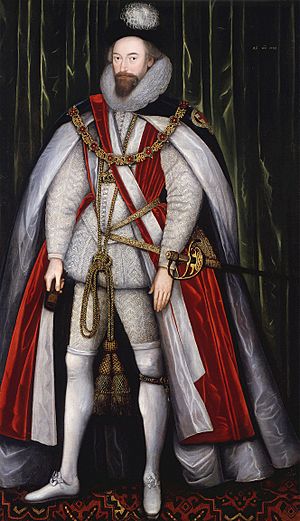
In early 1558, Norfolk became betrothed to Margaret Audley, widow of Sir Henry Dudley and daughter of Thomas Audley, 1st Baron Audley of Walden and his second wife Elizabeth Grey. Thus Margaret was a first cousin of Mary FitzAlan and in order for the marriage to be valid under Catholic canon law, a dispensation had to be requested from Pope Paul IV, due to the close relationship between Thomas' first wife and Audley. Howard sent lawyers to Rome to negotiate for the dispensation, but the Holy See was notorious for its delays where dispensations were concerned. These delays, added to the fact that in November of the same year Queen Mary died and was succeeded by Queen Elizabeth, who began to restore Protestantism, led to the marriage being celebrated without the dispensation. It was ratified by Parliament in March 1559. Margaret brought as dowry to her marriage with Howard the entirety of the extensive properties that she had inherited from her father in Essex, including the magnificent Audley End residence.
Norfolk's children by his marriage to Margaret were:
- Lady Elizabeth Howard (1560–?), who died in early childhood.
- Thomas Howard, 1st Earl of Suffolk (1561–1626), who firstly married his step-sister, Mary Dacre, without issue. He married secondly Katherine Knyvet c. 1583 and had issue.
- Lady Margaret Howard (1562–1591), who married Robert Sackville, 2nd Earl of Dorset and had issue.
- Lord William Howard of Naworth Castle and Henderskelfe Castle (now the site of Castle Howard) (1563–1640), who married his step-sister Elizabeth Dacre and had issue.
At Christmas 1563, Margaret, anxious to be reunited with her husband, left Audley End, despite being still weak from the birth of her fourth child a few days before. During the journey, she fell ill with a respiratory condition that worsened as the days went by and she died in Norwich on 9 January 1564. The Duchess was buried in the first instance in St. John the Baptist's Church in Norwich, although shortly afterwards her remains were moved to St Michael the Archangel's Church, Framlingham, the grave being decorated with her heraldic quarterings and her funerary effigy, which is displayed with the peerage robes.
Third wife
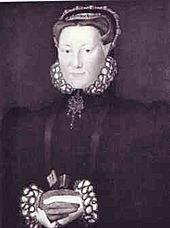
Shortly after Margaret's death, Norfolk married Elizabeth Leyburne (1536 – 4 September 1567), widow of Thomas Dacre, 4th Baron Dacre of Gillesland and daughter of Sir James Leyburn. They had no children.
Norfolk's three sons by his first two wives, Philip, Thomas and William, married, respectively, Anne, Margaret, and Elizabeth Dacre. The Dacre sisters were the daughters of Elizabeth Leyburne by her marriage to Thomas Dacre and were therefore stepsisters to Norfolk's sons.
Elizabeth died in September 1567, shortly after giving birth to a baby, whose sex is not known and who also died. She was buried at St. Mary's Church, Kenninghall.
Depictions
- Thomas Howard appears as a character in the Philippa Gregory novels The Virgin's Lover and The Other Queen, and in the novel I, Elizabeth by Rosalind Miles.
- A highly fictionalised version of the Duke, played by Christopher Eccleston, is in the 1998 film Elizabeth.
- Another version of the Duke is in the BBC mini-series The Virgin Queen, played by Kevin McKidd.
- In the Channel 4 documentary Elizabeth (2000) presented by David Starkey, the Duke is portrayed by actor John Gully.
Family tree
Through his maternal and paternal lineages, Howard was related to the most important families of the English and Welsh nobility. Through his ancestor Jacquetta of Luxembourg, he was related to Royal House of Luxembourg and with part of the French and Italian nobility (Orsini family). Through his maternal great-great-grandfather, John Donne, Howard was a descendant of Owain Glyndŵr, the last native Prince of Wales.
|
|
|
|
|
|
|
|
|
|
|
|
|
|
|
|
|
|
|
|
16. John Howard, 1st Duke of Norfolk | |||||||||||||||
|
|
||||||||||||||||
|
|
|
|
|
|
||||||||||||
|
|
8. Thomas Howard, 2nd Duke of Norfolk |
|
||||||||||||||
|
|
||||||||||||||||
|
|
|
|
|
|
|
|
|
|||||||||
|
|
17. Katherine Moleyns | |||||||||||||||
|
|
||||||||||||||||
|
|
|
|
|
|
||||||||||||
|
|
4. Thomas Howard, 3rd Duke of Norfolk |
|
||||||||||||||
|
|
||||||||||||||||
|
|
|
|
|
|
|
|
|
|
|
|
||||||
|
|
18. Sir Frederick Tilney | |||||||||||||||
|
|
||||||||||||||||
|
|
|
|
|
|
||||||||||||
|
|
9. Elizabeth Tilney, Countess of Surrey |
|
||||||||||||||
|
|
||||||||||||||||
|
|
|
|
|
|
|
|
|
|||||||||
|
|
19. Elizabeth Cheney | |||||||||||||||
|
|
||||||||||||||||
|
|
|
|
|
|
||||||||||||
|
|
2. Henry Howard, Earl of Surrey |
|
||||||||||||||
|
|
||||||||||||||||
|
|
|
|
|
|
|
|
|
|
|
|
|
|
|
|||
|
|
20. Henry Stafford, 2nd Duke of Buckingham | |||||||||||||||
|
|
||||||||||||||||
|
|
|
|
|
|
||||||||||||
|
|
10. Edward Stafford, 3rd Duke of Buckingham |
|
||||||||||||||
|
|
||||||||||||||||
|
|
|
|
|
|
|
|
|
|||||||||
|
|
21. Catherine Woodville | |||||||||||||||
|
|
||||||||||||||||
|
|
|
|
|
|
||||||||||||
|
|
5. Elizabeth Stafford |
|
||||||||||||||
|
|
||||||||||||||||
|
|
|
|
|
|
|
|
|
|
|
|
||||||
|
|
22. Henry Percy, 4th Earl of Northumberland | |||||||||||||||
|
|
||||||||||||||||
|
|
|
|
|
|
||||||||||||
|
|
11. Eleanor Percy, Duchess of Buckingham |
|
||||||||||||||
|
|
||||||||||||||||
|
|
|
|
|
|
|
|
|
|||||||||
|
|
23. Maud Herbert, Countess of Northumberland | |||||||||||||||
|
|
||||||||||||||||
|
|
|
|
|
|
||||||||||||
|
|
1. Thomas Howard, 4th Duke of Norfolk |
|
||||||||||||||
|
|
||||||||||||||||
|
|
|
|
|
|
|
|
|
|
|
|
|
|
|
|
|
|
|
|
24. Robert de Vere | |||||||||||||||
|
|
||||||||||||||||
|
|
|
|
|
|
||||||||||||
|
|
12. John de Vere |
|
||||||||||||||
|
|
||||||||||||||||
|
|
|
|
|
|
|
|
|
|||||||||
|
|
25. Joan Courtenay | |||||||||||||||
|
|
||||||||||||||||
|
|
|
|
|
|
||||||||||||
|
|
6. John de Vere, 15th Earl of Oxford |
|
||||||||||||||
|
|
||||||||||||||||
|
|
|
|
|
|
|
|
|
|
|
|
||||||
|
|
13. Alice Kirlington |
|
||||||||||||||
|
|
||||||||||||||||
|
|
|
|
|
|
|
|
|
|||||||||
|
|
3. Frances de Vere |
|
||||||||||||||
|
|
||||||||||||||||
|
|
|
|
|
|
|
|
|
|
|
|
|
|
|
|||
|
|
14. Edward Trussell |
|
||||||||||||||
|
|
||||||||||||||||
|
|
|
|
|
|
|
|
|
|||||||||
|
|
7. Elizabeth Trussell |
|
||||||||||||||
|
|
||||||||||||||||
|
|
|
|
|
|
|
|
|
|
|
|
||||||
|
|
30. Sir John Donne (1450–1503) | |||||||||||||||
|
|
||||||||||||||||
|
|
|
|
|
|
||||||||||||
|
|
15. Margaret Donne |
|
||||||||||||||
|
|
||||||||||||||||
|
|
|
|
|
|
|
|
|
|||||||||
|
|
31. Elizabeth Hastings (c.1450 – 1508) | |||||||||||||||
|
|
||||||||||||||||
|
|
|
|
|
|
||||||||||||



